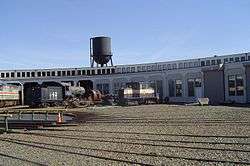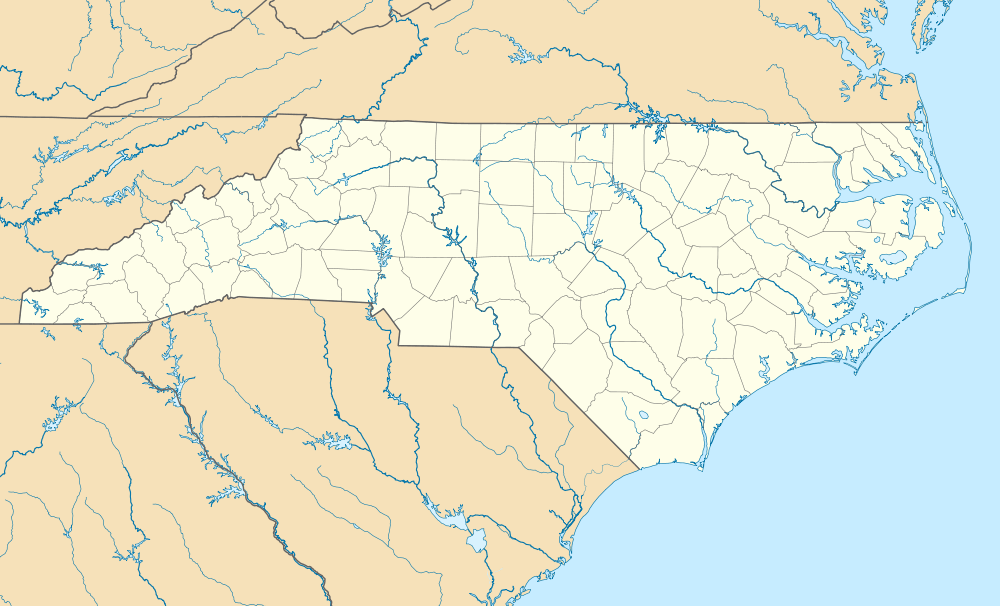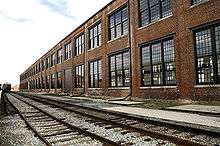Southern Railway's Spencer Shops
Southern Railway's Spencer Shops were a major steam locomotive repair facility between Atlanta and Washington, D.C. in Spencer, North Carolina.[2] The service facility was once Southern Railway's largest steam locomotive repair center. The period of greatest prosperity and productivity for the facility was in the first half of the twentieth century.[3] These type of repair service facilities for the railroads were called "back shops". They were located in every division of a railroad system and centralized for the most extensive kinds of repairs.[3]
Southern Railway Spencer Shops | |
 Spencer Shops turntable service facility | |
  | |
| Location | Spencer, North Carolina |
|---|---|
| Coordinates | 35°41′13″N 80°26′10″W |
| Area | 57 acres (23 ha) |
| Built | 1896 |
| Built by | Southern Railway Co. |
| NRHP reference No. | 78001972[1] |
| Added to NRHP | March 17, 1978 |
The Spencer Shops "back shops" were named in honor of the first president of the Southern Railway, Samuel Spencer (1847 – 1906), as was the name of the new town developed for these facilities.[2][4] The Spencer Shops were located near Salisbury, North Carolina. The conversion from steam locomotives to diesel locomotives caused the demise of the Spencer Shops. They were phased out from the 1950s to the 1970s.[2] The former Spencer Shops complex is now part of the North Carolina Transportation Museum.[4]
History
Development
The financial firm of Drexel, Morgan and Company created the newly formed Southern Railway Company in 1894 following the financial failure of the Richmond and Danville Railroad system, which had included the East Tennessee, Virginia and Georgia Railroad, and several other smaller railroads.[5] The finance company's railroad expert was Samuel Spencer, who had previously served as superintendent of the Long Island Rail Road in 1878 and headed the Baltimore and Ohio Railroad (1887–1888).[6] J. Pierpont Morgan tapped Samuel Spencer to head the new enterprise, one of the largest in the United States.[5]
The new Southern Railway began with two major repair facilities, one in Atlanta, Georgia, the other in Knoxville, Tennessee.[5] Much of the inherited rolling stock from the acquisitions of the defunct railroads were in need of major repairs.[5] The two "back shop" service centers couldn't handle this extensive service need.[2] Spencer noted the facilities were poorly equipped for their purposes.[2] He saw the need for a third major "back shop" service facility on this eastern main line between Washington D.C. and Atlanta.[2] He reported also in the first annual meeting of June 1895 "one additional large shop may be necessary."[2] This way the repair facilities would be divided up into segments of about 160 miles (260 km) apart.[2] The switch locomotives needed to be inspected for repair and service and refueled at this increment.[2] The new major "back shop" service facility was proposed to be in the middle of these two major cities.[2][4]
Henderson acquisitions

The development of the facilities for Spencer Shops started with John Steele Henderson.[2] He was a Confederate veteran, a former state senator and Rowan county's largest landholder at the time.[2] History records that Henderson entered into secret negotiations with Southern Railway officials for land acquisitions for the proposed major facility to act as a type of front dummy entity to prevent price speculating.[2] He was to buy the land secretly for the new shop complex and sell it back to the railroad at or near the low price he paid.[2] This decision was taken because in 1896 it was already publicly known that the Southern Railway was looking for potential land for this facility, though at the time the Charlotte area was seen as the logical choice for the complex.[2]
In January 1896, Henderson began buying large tracts of land two miles (3 km) north of Salisbury directly on Southern Railroad's main line.[2] He then sold most of it back to the Southern Railway for slightly more than he paid for it.[2] Henderson further profited from the arrangement by selling land that he owned in the area to people that worked for the shops. At the turn of the century he also sold some land from the deal that he had kept for himself back to Southern Railway for a large profit.[2] The workmen turned the first shovels of 75,000 cubic yards (57,000 m3) of dirt for construction on March 23, 1896. Spencer officially opened the shops on August 19, 1896.[2]

Town of Spencer
Spencer Shops had thousands of skilled workers.[2] They were engineers, firemen, brakemen, and conductors.[2] Many of them settled down in the area and the town of Spencer was formed.[2] Initially Southern Railway partitioned 84 acres (340,000 m2) into 500 lots; 50 × 145 for residential lots and 25 × 145 for commercial lots.[2] They sold for $100 each. The 625 residents of Spencer were granted incorporation by North Carolina legislature in 1901.[2]
Notes
- "National Register Information System". National Register of Historic Places. National Park Service. July 9, 2010.
- The History of the railroad and Spencer - North Carolina Transportation Museum Archived 2007-02-05 at the Wayback Machine
- Workers outside Southern Railway's Spencer Shops - history of Spencer Shops
- North Carolina Transportation Museum - History of Spencer Shops
- "The History of the railroad and Spencer". North Carolina Transportation Museum. Archived from the original on 2007-02-05. Retrieved 2007-01-25.
- "PRR Chronology: 1878" (PDF). Retrieved 2007-01-25.
References
- Cates, Pat C., The Southern Railway: Further Recollections, Arcadia Publishing Company (2005), ISBN 1-883089-23-9
- McQuigg, Jackson, History on Steel Wheels, North Carolina Transportation History Corporation (1996), ISBN 0-9642749-0-6.
- Galloway, Duane and Wrinn, Jim, Southern Railway's Spencer Shops, 1896-1996, T L C Publishing (1996), ISBN 978-1-883089-23-8
External links
- Historic American Engineering Record (HAER) No. NC-8, "Southern Railway Company, Spencer Shops, Salisbury Avenue between Third and Eight Streets, Spencer, Rowan County, NC", 10 photos, 4 measured drawings, 29 data pages, 1 photo caption page
- Railroad lines abandoned by the Southern Railway
- Southern Railway Historical Association containing Spencer Shops history
Further reading
- "Southern Railway in Color Volume 2" by Alton Lanier. Published by Morning Sun Books Inc. ISBN 1-58248-014-1.
- "The Southern Railway Remembered" by James Leslie Hepler, publisher Motorbooks International, ISBN 1-883089-63-8.
- The Southern Railway: Road of Innovators by Burke Davis, University of North Carolina Press (1985), ISBN 0-8078-1636-1
- "Southern Railway Panorama" by Frederick A. Kramer. Published by Quadrant Press, Inc., New York, ISBN 0-915276-20-8
- "Southern Railway Varnish 1964 - 1979" by Ralph Ward, Original at University of North Carolina, Chapel Hill, ISBN 0-9622999-2-8.
- The Southern Railway System An Illustrated History by William Webb. Published by The Boston Mills Press. ISBN 0-919783-19-8.
- The Southern Railway Steam - Locomotives and trains 1935 - 1937 from the collection of Robert K. Durham, ISBN 0-9644480-6-8.
- "Southern Railway in Color " by Fred Cheney and David R. Sweetland. Published by Morning Sun Books Inc. ISBN 1-878887-14-9.
- "Southern Railway Color Guide to Freight and Passenger Equipment" by James Kinkaid. Published by Morning Sun Books Inc. ISBN 1-878887-60-2.
- "Southern Railway System A Pictorial Album Washington to Atlanta, 1960 - 1982" by Douglas B. Nuckles, Four Way West Publications, ISBN 1-885614-09-8.

